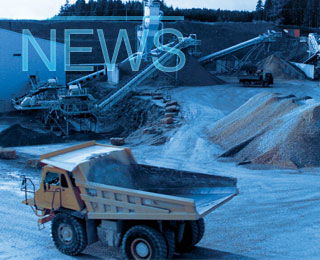The Mineral Products Association's (MPA) fourth Annual Mineral Planning Survey (AMPS4), covering the period to the end of 2014, shows that although the demand for aggregates continues to recover but the findings brings into sharper focus the problems of declining reserves that were raised in previous surveys.
"Unless action is taken on updating and extending the coverage of mineral plans and speeding up the planning process the construction industry will face increasing supply challenges particularly local sand and gravel," the MPA has warned.
Key findings from the AMPS4
• Sales – in 2014, total MPA sales of land-won sand and gravel and crushed rock in GB increased by 6.1 and 13.5 per cent respectively, reflecting growth in overall construction and economic activity.
• Replenishment of aggregate reserves – sand and gravel is being severely under–replenished as reserves are used twice as fast as new capacity is being permitted. Crushed rock is superficially being replenished but this is skewed by a few large permissions which mask general under-replenishment elsewhere.
• Numbers of planning applications – operators have been slow to respond to the upturn whilst local authorities may not have the capacity to deal effectively with an expected surge in applications.
• Appeals – ‘planning by appeal’ remains an unattractive option for operators with very low numbers being submitted due to the time, cost and uncertainty.
• Numbers of planning decisions – decisions are low in line with the comparatively low level of applications.
• Time taken to obtain permission – it still takes almost 3 years on average to secure permission for both sand and gravel and crushed rock reserves although this is only a part of an overall period of up to 15 years from site identification to production.
• Shares of national provision – remain stable but figures dominated by one large permission in Scotland.
The data, which shows the interface between mineral operators and the land use planning system, is derived from original MPA data together with information from the annual Aggregate Working Party reports. In the last few years, this work has been compiled in the form of the MPA Annual Mineral Planning Survey (AMPS) reports.
Announcing the publication of AMPS4, MPA chief executive Nigel Jackson said: “It is good news that there is a continuing increase in the demand for aggregates and a growth in construction and economic activity during 2014.The report highlights the fact that insufficient new reserves are being permitted particularly sand and gravel and this continues to be a real concern. With over half of new permissions being for sites that have not yet been allocated in mineral plans, it is clear that the plan led system is not providing the certainty that it should.”
Commenting on continuing concerns that are apparent from the report, Mr Jackson noted: “I hope that both government and planning authorities will take notice of the messages from AMPS4 and give more commitment to speeding up both the plan making system and the processing of planning applications, otherwise maintaining a ‘steady and adequate supply’ will become increasingly difficult over the longer term.
"Investing in the skills required by planning authorities to handle aggregates and quarrying issues is vital. We think that better use could be made of the talent that is already in place by sharing specialist officers between authorities to create ‘centres of mineral planning excellence’.
"We also believe that urgent attention needs to be given to improving the interface between planning and the key permitting functions of the Environment Agency and Natural England, which should be far more integrated. Last but not least, the primacy of planning over permitting must be re-established if we are to tackle this replenishment issue by giving operators the confidence they need to submit more applications.”
